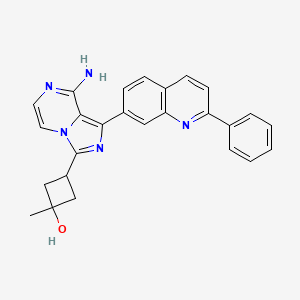


API Suppliers
0

US DMFs Filed
0

CEP/COS Certifications
0

JDMFs Filed
0
Other Certificates
0
Other Suppliers
0
0
0

USA (Orange Book)
0

Europe
0

Canada
0

Australia
0

South Africa
0
Uploaded Dossiers
0
U.S. Medicaid
0
Annual Reports
0
0
USFDA Orange Book Patents
0
USFDA Exclusivities
0
Blog #PharmaFlow
0
News
0
EDQM
0
USP
0
JP
0
Other Listed Suppliers
0
0


1. 3-(8-amino-1-(2-phenylquinolin-7-yl)imidazo(1,5-a)pyrazin-3-yl)-1-methylcyclobutanol
2. Osi 906
3. Osi-906
4. Osi906
1. 867160-71-2
2. Osi-906
3. Linsitinib(osi-906)
4. Osi906
5. Osi 906
6. Osi-906aa
7. Osi-906 (linsitinib)
8. Asp-7487
9. 3-[8-amino-1-(2-phenylquinolin-7-yl)imidazo[1,5-a]pyrazin-3-yl]-1-methylcyclobutan-1-ol
10. 15a52gpt8t
11. Chembl1091644
12. Mmv676605
13. Cis-3-(8-amino-1-(2-phenyl-7-quinolinyl)imidazo(1,5-a)pyrazin-3-yl)-1-methylcyclobutanol
14. (1r,3r)-3-(8-amino-1-(2-phenylquinolin-7-yl)imidazo[1,5-a]pyrazin-3-yl)-1-methylcyclobutanol.
15. Linsitinib [usan]
16. Kinome_3532
17. Linsitinib [usan:inn]
18. Unii-15a52gpt8t
19. Cis-3-(8-amino-1-(2-phenylquinolin-7-yl)imidazo(1,5-a)pyrazin-3-yl)-1-methylcyclobutan-1-ol
20. Cis-3-(8-amino-1-(2-phenylquinolin-7-yl)imidazo[1,5-a]pyrazin-3-yl)-1-methylcyclobutan-1-ol
21. Linsitinib; Osi-906
22. Linsitinib [inn]
23. Linsitinib (usan/inn)
24. Linsitinib (osi-906)
25. Linsitinib [who-dd]
26. Mls006010304
27. Schembl400369
28. Schembl400734
29. Schembl400735
30. Gtpl7423
31. Chembl1996234
32. Schembl10255925
33. Chebi:91402
34. Ex-a719
35. Bcpp000137
36. Bdbm185150
37. Dtxsid401007055
38. Dtxsid901121553
39. Hms3295g15
40. Hms3654c19
41. Bcp01831
42. Bdbm50315887
43. Mfcd12912153
44. Nsc756652
45. Nsc800784
46. S1091
47. Zinc53239527
48. Akos024464740
49. Zinc100071817
50. Zinc113742575
51. Bcp9001035
52. Ccg-264815
53. Cs-0242
54. Db06075
55. Nsc-756652
56. Nsc-800784
57. Pb22643
58. Ncgc00250375-02
59. Ncgc00250375-03
60. Ncgc00250375-11
61. Ncgc00250375-14
62. Ac-26953
63. As-16999
64. Hy-10191
65. Smr004700744
66. Ft-0670821
67. Sw218150-2
68. D09925
69. Sr-05000022538
70. J-520074
71. Q6554803
72. Sr-05000022538-1
73. Brd-k07667918-001-01-3
74. Q27163260
75. 3-[8-amino-1-(2-phenyl-7-quinolinyl)-3-imidazo[1,5-a]pyrazinyl]-1-methyl-1-cyclobutanol
76. (1s,3s)-3-(8-amino-1-(2-phenylquinolin-7-yl)imidazo[1,5-a]pyrazin-3-yl)-1-methylcyclobutanol
77. 1356958-77-4
78. 3-(8-amino-1-(2-phenylquinolin-7-yl)-2,3-dihydroimidazo[1,5-a]pyrazin-3-yl)-1-methylcyclobutanol
79. 3-[8-amino-1-(2-phenyl-quinolin-7-yl)-imidazo[1,5-a]pyrazin-3-yl]-1-methyl-cyclobutanol
80. 867160-72-3
81. Cis-3-(8-amino-1-(2-phenylquinolin-7-yl)imidazo(1,5-a)pyrazin-3-yl)-1-methylcyclobutanol
82. Cyclobutanol, 3-(8-amino-1-(2-phenyl-7-quinolinyl)imidazo(1,5-a)pyrazin-3-yl)-1-methyl-, Cis-
83. Trans-3-[8-amino-1-(2-phenyl-7-quinolinyl)imidazo[1,5-a]pyrazin-3-yl]-1-methylcyclobutanol
| Molecular Weight | 421.5 g/mol |
|---|---|
| Molecular Formula | C26H23N5O |
| XLogP3 | 4.2 |
| Hydrogen Bond Donor Count | 2 |
| Hydrogen Bond Acceptor Count | 5 |
| Rotatable Bond Count | 3 |
| Exact Mass | 421.19026037 g/mol |
| Monoisotopic Mass | 421.19026037 g/mol |
| Topological Polar Surface Area | 89.3 Ų |
| Heavy Atom Count | 32 |
| Formal Charge | 0 |
| Complexity | 663 |
| Isotope Atom Count | 0 |
| Defined Atom Stereocenter Count | 0 |
| Undefined Atom Stereocenter Count | 0 |
| Defined Bond Stereocenter Count | 0 |
| Undefined Bond Stereocenter Count | 0 |
| Covalently Bonded Unit Count | 1 |
Investigated for use/treatment in cancer/tumors (unspecified) and solid tumors.
In laboratory studies of 28 human tumor cell lines, OSI-906 reduced growth of 15 cell lines representative of colorectal, lung, breast, pancreatic, and pediatric tumors and in mouse models. OSI-906 was particularly effective against tumors that are highly IGF-dependent such as colorectal cancers. According to the researchers, OSI-906 not only slowed tumor growth in mice, but decreased the size of some pre-existing tumors.
IGF-1R stimulates proliferation, enables onogenic transformation, and suppresses apoptosis. Inhibitors of IGF-1R are expected to have broad utility in oncology since the over-expression of IGF-1R and/or its ligands or the down-regulation of ligand binding proteins occurs in numerous human malignancies including lung, colon, breast, prostate, brain and skin cancers. In addition, signaling through the IGF system has been implicated in protecting tumor cells from apoptosis induced by anti-cancer treatments such as cytotoxic agents and EGFR inhibitors.


